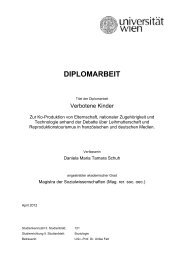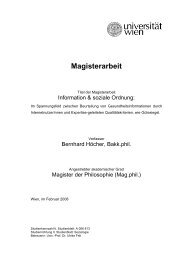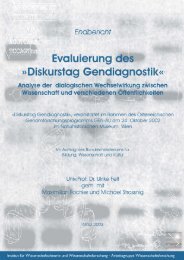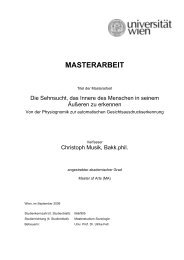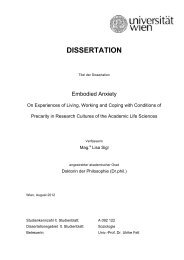MASTERARBEIT - Institut für Wissenschaftsforschung - Universität ...
MASTERARBEIT - Institut für Wissenschaftsforschung - Universität ...
MASTERARBEIT - Institut für Wissenschaftsforschung - Universität ...
You also want an ePaper? Increase the reach of your titles
YUMPU automatically turns print PDFs into web optimized ePapers that Google loves.
2.2 count zeppelin’s airships: a brief overview 13<br />
but had never seen a technical object – and by no means one of over<br />
120 meters in length – fly in their entire life. Apart from that, analysis<br />
of this fascination for the ship by Frank [15] comes to conclusions<br />
agreeing with what Eckener thought about the ship: the aesthetics of<br />
form and material of the ship were very appealing (»Ich habe immer<br />
das Gefühl gehabt, dass solche Wirkungen, wie sie vom Zeppelin-<br />
Luftschiff ausgingen, zu einem großen Teil auf ästhetischen Empfindungen<br />
beruhten«, [12, 403]). Further factors that played a role are<br />
the subject of my analysis and will be analyzed in later chapters as I<br />
think those reasons given above are not all there is to tell about that<br />
issue. Particularly the step from passive admiration to active support<br />
seems to have drawn upon more than just an appealing exterior and<br />
the fact this appealing shape was flying. This point is going to be<br />
revisited later on as its key to my analysis. The 24-hour test had to be<br />
paused once due to a defect near Mainz and then to be canceled after<br />
about 3/4 of the scheduled distance because of a failing engine after<br />
all. Therefore, the ship landed in Echterdingen near Stuttgart. The<br />
site was chosen because nearby the Daimler workshops, responsible<br />
for the zeppelin’s engines, were located. Thus, Zeppelin hoped for a<br />
quick and easy repair. A storm in the afternoon of August 5th, however,<br />
destroyed the ship. It caught fire and burned down completely<br />
before the ship could be fixed [11, 161]. Similarly to what happened<br />
to the famous LZ-129 »Hindenburg« 28 years later at Lakehurst, New<br />
Jersey, early zeppelins were filled with easily flammable hydrogen<br />
and hence very vulnerable to fire. The destruction of LZ-4 put an<br />
end to the endurance test without having fulfilled the military’s conditions<br />
for purchasing LZ-3 and LZ-4. It seemed like the final failure<br />
of his project, and Zeppelin was prepared to burry his dream at this<br />
point.<br />
But his fate turned fast: within hours after the crash, all over Germany<br />
a grassroots-movement started to donate money for Zeppelin.<br />
During the past weeks and culminating in his test flight that day, his<br />
endeavor was no longer seen as a foolish attempt but as a project of<br />
national pride. Eckener makes a remark about the pride with which<br />
the zeppelin was regarded after the trip over Switzerland (original<br />
quote: »Das deutsche Volk las mit ungeheurem Stolz die Berichte<br />
über den Eindruck, den sie auf die ganze Welt gemacht hatte.« [11,<br />
159]. Within 24 hours, hundreds of thousands of Marks were donated<br />
to von Zeppelin, adding up to over 6 million Marks after a couple of<br />
weeks [11, 163]. This »miracle at Echterdingen« [16, 18] became the<br />
turning point for Zeppelin’s endeavor: finally equipped with sufficient<br />
funds, he was able put together an actual corporation and found<br />
subsidiaries to supply the actual airship construction with parts and<br />
know-how. As the military’s willingness to buy ships stayed small,<br />
DELAG, the world’s first airline was founded in order to purchase



